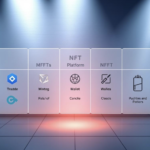Now Reading: Polkadot (DOT): Revolutionizing Blockchain Technology
- 01
Polkadot (DOT): Revolutionizing Blockchain Technology
Polkadot (DOT): Revolutionizing Blockchain Technology

In the ever-evolving landscape of blockchain technology, Polkadot (DOT) has emerged as a pioneering force, poised to revolutionize the way blockchain networks interact and scale. This innovative platform, designed to facilitate seamless cross-chain communication and enhanced scalability, is paving the way for a more interconnected and efficient Web3 ecosystem.
At the heart of Polkadot’s groundbreaking approach lies its unique architecture, which enables a diverse network of specialized blockchains, known as parachains, to operate in parallel and communicate with one another. This bold move towards interoperability and scalability is transforming the very foundations of the blockchain industry, allowing for the development of more robust and versatile decentralized applications (dApps).
Key Takeaways
- Polkadot (DOT) is a pioneering blockchain platform that enables seamless cross-chain communication and enhanced scalability.
- Polkadot’s unique architecture allows for a network of specialized blockchains, known as parachains, to operate in parallel and communicate with one another.
- Polkadot’s approach to interoperability and scalability is revolutionizing the blockchain industry, paving the way for more robust and versatile decentralized applications (dApps).
- Polkadot’s Nominated Proof-of-Stake (NPoS) consensus mechanism ensures a secure and decentralized network.
- The Polkadot (DOT) token is the lifeblood of the network, powering transactions and governance.
- Polkadot’s ecosystem is thriving, with a growing number of prominent projects and dApps building on the platform.
- The future of Polkadot holds both challenges and exciting opportunities as the platform continues to push the boundaries of blockchain technology.
What is Polkadot (DOT)?
Polkadot is a revolutionary blockchain platform that aims to revolutionize the world of decentralized technologies. Developed by the Web3 Foundation, Polkadot is designed to address the challenges of blockchain interoperability, scalability, and security.
Overview of Polkadot’s Blockchain Platform
At the heart of Polkadot is the Relay Chain, which serves as the central hub for the network. The Relay Chain is responsible for coordinating the various Parachains, which are parallel blockchains that can be customized for specific use cases. This unique architecture allows Polkadot to achieve unprecedented scalability and flexibility, enabling the seamless exchange of data and assets across different blockchains.
Key Features and Innovations
Polkadot’s key features and innovations include:
- Interoperability: Polkadot’s Relay Chain enables cross-chain communication and asset transfer, breaking down the siloed nature of traditional blockchains.
- Scalability: The Parachain architecture allows Polkadot to process transactions in parallel, significantly increasing the network’s overall throughput.
- Customizability: Developers can build specialized Parachains tailored to their specific needs, leveraging Polkadot’s robust Substrate framework.
- Security: Polkadot’s Nominated Proof-of-Stake consensus mechanism ensures a secure and decentralized network, with a strong focus on safeguarding user assets.
By addressing the limitations of existing blockchain platforms, Polkadot aims to pave the way for a more interconnected, scalable, and user-friendly Web3 ecosystem.
Polkadot’s Relay Chain: The Backbone of Blockchain Interoperability
At the heart of Polkadot’s innovative architecture lies the Relay Chain, a central hub that enables seamless cross-chain communication and blockchain interoperability. This fundamental component of the Polkadot network serves as the backbone, facilitating the exchange of data and assets between the various Parachains connected to the system.
The Relay Chain acts as a secure and reliable intermediary, allowing Parachains to interact with one another without the need for complex bridging mechanisms. This Relay Chain architecture empowers developers to create a diverse ecosystem of specialized blockchains, each focused on a specific use case or application, while still maintaining seamless cross-chain communication.
By serving as the central nervous system of the Polkadot network, the Relay Chain enables a new level of scalability and flexibility. Parachains can leverage the security and consensus mechanisms provided by the Relay Chain, while enjoying the ability to customize their own unique features and functionalities.
| Key Features of the Polkadot Relay Chain | Benefits |
|---|---|
| Cross-Chain Communication | Enables seamless data and asset transfers between Parachains |
| Blockchain Interoperability | Facilitates the integration and collaboration of diverse blockchain-based systems |
| Secure and Reliable Consensus | Provides a robust and decentralized foundation for the entire Polkadot network |
The Relay Chain’s pivotal role in Polkadot’s architecture underscores the project’s commitment to building a truly interconnected and scalable blockchain ecosystem, paving the way for the next generation of decentralized applications and services.
“The Relay Chain is the backbone of the Polkadot network, enabling seamless communication and collaboration between Parachains.”
Parachains: Parallel Blockchains for Scalability and Flexibility
At the heart of the Polkadot ecosystem lie the Parachains – parallel blockchains that connect to the Polkadot Relay Chain. These Parachains are designed to provide scalability, flexibility, and cross-chain communication, revolutionizing the way blockchain networks operate.
Parachain Auctions and Slot Allocation
To secure a Parachain slot on the Polkadot network, projects must participate in a competitive bidding process known as Parachain Auctions. These auctions allow Parachain teams to lock up their Polkadot (DOT) tokens for a set period, vying for the limited Parachain slots available. The successful bidders are then granted the right to operate their Parachain, contributing to the overall security and interoperability of the Polkadot ecosystem.
Cross-Chain Communication and Asset Transfers
One of the key advantages of Parachains is their ability to communicate with each other and the Polkadot Relay Chain. This cross-chain communication enables seamless asset transfers and the sharing of data between different Parachains, breaking down the barriers that have traditionally existed between blockchain networks. This feature allows for the development of more complex and interoperable decentralized applications (dApps) on the Polkadot network.
By leveraging the Parachains’ capabilities, Polkadot is paving the way for a more scalable, flexible, and interconnected blockchain landscape, empowering developers to build innovative solutions that can thrive in the growing Web3 ecosystem.
Nominated Proof-of-Stake: A Secure and Decentralized Consensus Mechanism
Polkadot’s blockchain network employs a unique Nominated Proof-of-Stake (NPoS) consensus mechanism, ensuring a secure and decentralized platform. This innovative approach to consensus differs from traditional Proof-of-Work (PoW) or Proof-of-Stake (PoS) models, offering enhanced security and scalability.
In the NPoS system, network participants called “nominators” stake their Polkadot (DOT) tokens to support validator nodes, which are responsible for validating and producing new blocks. Validators are selected based on their staked amount and reputation, promoting a decentralized and fair validation process.
| Key Features of Nominated Proof-of-Stake | Benefits |
|---|---|
| Staking and Nomination of Validators | Encourages decentralization and participation |
| Dynamic Validator Selection | Ensures the most reputable and well-capitalized validators are chosen |
| Incentive Mechanisms | Rewards validators and nominators for their contributions to the network |
| Slashing Penalties | Deters validator misbehavior and promotes network integrity |
The Nominated Proof-of-Stake consensus mechanism employed by Polkadot is a crucial component of the network’s overall decentralization and security. By involving a diverse set of stakeholders, the system ensures the network’s resilience and the integrity of the consensus mechanism.

Web3 and Decentralized Applications on Polkadot
As the internet continues to evolve, the emergence of Web3 promises a new era of decentralized applications (dApps) that empower users with greater control over their data and identity. At the forefront of this revolution is Polkadot, a cutting-edge blockchain platform designed to facilitate the creation and deployment of these transformative dApps.
Building Decentralized Apps with Substrate
Polkadot’s Substrate framework provides developers with a robust and flexible toolkit for building Web3 dApps. By leveraging Substrate’s modular design, developers can easily create custom blockchain solutions tailored to their specific needs, while benefiting from Polkadot’s core infrastructure and security features.
The Substrate framework empowers developers to focus on the unique functionality and user experience of their decentralized applications, without having to reinvent the wheel when it comes to core blockchain mechanics. This streamlined approach accelerates the development and deployment of innovative dApps on the Polkadot network.
Furthermore, Substrate’s interoperability with Polkadot’s Relay Chain ensures seamless cross-chain communication and asset transfers, enabling dApps to tap into the broader Web3 ecosystem and expand their reach and functionality.
“Polkadot’s Substrate framework is a game-changer for Web3 development, empowering developers to build cutting-edge decentralized applications that unlock new levels of user control and innovation.”
As the Web3 movement gains momentum, Polkadot’s Substrate framework is poised to become a leading platform for the development and deployment of transformative decentralized applications that redefine the digital landscape.
Polkadot (DOT) Token: Powering the Network
The Polkadot (DOT) token is the lifeblood of the Polkadot network, serving as the primary means of powering and securing the platform. As a multi-chain network, Polkadot requires a native token to facilitate various functionalities, from governance and staking to network maintenance and cross-chain communication.
At the heart of the Polkadot ecosystem, the DOT token plays a crucial role in the network’s operations. Holders of DOT can participate in the governance of the network, voting on key decisions that shape the platform’s future. Additionally, DOT is used for staking, allowing users to contribute to the network’s security and earn rewards for their participation.
The DOT token is also essential for the operation of Polkadot’s parachains, the parallel blockchains that run alongside the Relay Chain. Parachains must acquire DOT tokens through auctions to secure a slot on the Polkadot network, enabling them to leverage the Relay Chain’s interoperability and cross-chain functionalities.
Ultimately, the Polkadot (DOT) token is the driving force behind the network, providing the necessary fuel to power Polkadot’s innovative blockchain architecture and ensure its long-term sustainability. As the Polkadot ecosystem continues to evolve, the DOT token will remain a central component in the network’s growth and the realization of its vision for a more connected and decentralized future.

“The DOT token is the backbone of the Polkadot network, enabling seamless cross-chain communication and powering the entire ecosystem.”
Polkadot’s Ecosystem: Projects and Partnerships
The Polkadot ecosystem is thriving, with a diverse array of projects and decentralized applications (dApps) building on the platform. These innovative collaborations are driving the adoption and development of Polkadot’s unique blockchain technology.
Prominent Projects and Dapps on Polkadot
Polkadot has attracted a wide range of projects, each contributing to the platform’s capabilities and expanding its reach. Some of the prominent projects and dApps on Polkadot include:
- Kusama – Polkadot’s canary network, serving as a testbed for new features and innovations.
- Acala – A decentralized finance (DeFi) hub, offering a range of financial services and products.
- Moonbeam – A Polkadot parachain that provides a fully Ethereum-compatible development environment.
- Polkadex – A decentralized exchange (DEX) platform, facilitating seamless trading of digital assets.
- Centrifuge – A protocol that enables the tokenization of real-world assets on the Polkadot network.
These projects, and many others, are driving the growth and adoption of the Polkadot ecosystem, showcasing the platform’s versatility and potential to transform various industries.
In addition to these projects, Polkadot has also forged strategic partnerships with leading blockchain organizations, further strengthening its position in the decentralized technology landscape. These partnerships cover a wide range of areas, from cross-chain interoperability to developer tooling and infrastructure.
“Polkadot’s vibrant ecosystem is a testament to the platform’s ability to attract top-tier projects and foster innovative collaborations. The diverse range of applications being built on Polkadot is a clear indication of its transformative potential.”
As the Polkadot ecosystem continues to evolve, the potential for further growth and integration of decentralized applications across various industries remains promising.
The Future of Polkadot: Challenges and Opportunities
As Polkadot continues to evolve and solidify its position in the blockchain ecosystem, it faces both challenges and opportunities that will shape its long-term trajectory. One of the key challenges is the need for the Polkadot community to address the concerns raised about the platform’s current state, including issues with marketing, user adoption, and governance.
However, Polkadot’s technological superiority and its potential to revolutionize blockchain interoperability present significant opportunities. The platform’s Polkadot Future hinges on its ability to drive greater user adoption, foster a more robust and cohesive community, and refine its governance model to ensure transparency and accountability. As Polkadot navigates these Challenges, it must also capitalize on its Opportunities to cement its position as a leading blockchain solution and fulfill its promise of a truly decentralized, interoperable, and scalable web3 ecosystem.
The success of Polkadot in the years ahead will be determined by its capacity to address the concerns raised by the community, enhance its marketing and adoption strategies, and implement a more streamlined and effective governance framework. By doing so, Polkadot can unlock its full potential and continue to push the boundaries of what is possible in the world of blockchain technology.
FAQ
What is Polkadot (DOT)?
Polkadot is an innovative blockchain platform that enables seamless communication and interoperability between different blockchain networks. It aims to create a decentralized web3 ecosystem by facilitating cross-chain transfers of any type of data or asset, not just tokens.
How does Polkadot’s architecture work?
Polkadot’s architecture consists of a Relay Chain that acts as the central hub, and Parachains – parallel blockchains that connect to the Relay Chain. The Relay Chain ensures security and facilitates cross-chain communication, while the Parachains can specialize in different use cases and scale independently.
What is the Polkadot Relay Chain?
The Polkadot Relay Chain is the central hub of the network that coordinates the Parachains and ensures the overall security and interoperability of the system. It is responsible for validating the transactions and blocks from the connected Parachains and facilitating cross-chain communication.
What are Parachains in Polkadot?
Parachains are specialized blockchains that are connected to the Polkadot Relay Chain. They can be customized for different use cases and can scale independently, while still benefiting from the security and interoperability provided by the Relay Chain.
How does Polkadot’s Parachain Auction and Slot Allocation work?
Polkadot uses a Parachain Auction system to allocate limited Parachain slots on the Relay Chain. Projects compete for these slots by locking up DOT tokens as a bond, and the successful projects are granted the right to operate a Parachain for a fixed period of time.
What is Nominated Proof-of-Stake (NPoS) in Polkadot?
Nominated Proof-of-Stake (NPoS) is the consensus mechanism used by Polkadot. It combines the Proof-of-Stake model with the concept of nomination, where token holders can “nominate” validators to participate in the block production and validation process, ensuring a secure and decentralized network.
How can developers build decentralized applications (dApps) on Polkadot?
Polkadot offers the Substrate framework, which allows developers to build custom blockchain networks or Parachains that can be integrated into the Polkadot ecosystem. This enables the creation of a wide range of decentralized applications (dApps) that can benefit from Polkadot’s interoperability and scalability features.
What is the Polkadot (DOT) token and how does it power the network?
The Polkadot (DOT) token is the native cryptocurrency of the Polkadot network. It serves various purposes, such as powering the Nominated Proof-of-Stake consensus mechanism, participating in Parachain Auctions, and facilitating governance decisions on the network.
What are some of the prominent projects and decentralized applications (dApps) on the Polkadot ecosystem?
Polkadot has a growing ecosystem of projects and decentralized applications (dApps) spanning various industries, including decentralized finance (DeFi), gaming, identity management, and more. Some prominent examples include Acala, Moonbeam, Polkadex, and Polkastarter.















